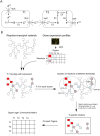A computational approach to estimate interorgan metabolic transport in a mammal
- PMID: 24971892
- PMCID: PMC4074118
- DOI: 10.1371/journal.pone.0100963
A computational approach to estimate interorgan metabolic transport in a mammal
Abstract
In multicellular organisms metabolism is distributed across different organs, each of which has specific requirements to perform its own specialized task. But different organs also have to support the metabolic homeostasis of the organism as a whole by interorgan metabolite transport. Recent studies have successfully reconstructed global metabolic networks in tissues and cell types and attempts have been made to connect organs with interorgan metabolite transport. Instead of these complicated approaches to reconstruct global metabolic networks, we proposed in this study a novel approach to study interorgan metabolite transport focusing on transport processes mediated by solute carrier (Slc) transporters and their couplings to cognate enzymatic reactions. We developed a computational approach to identify and score potential interorgan metabolite transports based on the integration of metabolism and transports in different organs in the adult mouse from quantitative gene expression data. This allowed us to computationally estimate the connectivity between 17 mouse organs via metabolite transport. Finally, by applying our method to circadian metabolism, we showed that our approach can shed new light on the current understanding of interorgan metabolite transport at a whole-body level in mammals.
Conflict of interest statement
Figures






Similar articles
-
METscout: a pathfinder exploring the landscape of metabolites, enzymes and transporters.Nucleic Acids Res. 2013 Jan;41(Database issue):D1047-54. doi: 10.1093/nar/gks886. Epub 2012 Sep 27. Nucleic Acids Res. 2013. PMID: 23019219 Free PMC article.
-
Roles of the interorgan neuronal network in the development of metabolic syndrome.Diabetol Int. 2016 Jul 5;7(3):205-211. doi: 10.1007/s13340-016-0277-8. eCollection 2016 Sep. Diabetol Int. 2016. PMID: 30603265 Free PMC article.
-
Proteomic analysis of the soybean symbiosome identifies new symbiotic proteins.Mol Cell Proteomics. 2015 May;14(5):1301-22. doi: 10.1074/mcp.M114.043166. Epub 2015 Feb 27. Mol Cell Proteomics. 2015. PMID: 25724908 Free PMC article.
-
Interorgan ammonia metabolism in health and disease: a surgeon's view.JPEN J Parenter Enteral Nutr. 1987 Nov-Dec;11(6):569-79. doi: 10.1177/0148607187011006569. JPEN J Parenter Enteral Nutr. 1987. PMID: 3323556 Review.
-
What do drug transporters really do?Nat Rev Drug Discov. 2015 Jan;14(1):29-44. doi: 10.1038/nrd4461. Epub 2014 Dec 5. Nat Rev Drug Discov. 2015. PMID: 25475361 Free PMC article. Review.
Cited by
-
Multi-Organ Contribution to the Metabolic Plasma Profile Using Hierarchical Modelling.PLoS One. 2015 Jun 18;10(6):e0129260. doi: 10.1371/journal.pone.0129260. eCollection 2015. PLoS One. 2015. PMID: 26086868 Free PMC article.
-
Identifying the individual metabolic abnormities from a systemic perspective using whole-body PET imaging.Eur J Nucl Med Mol Imaging. 2022 Jul;49(8):2994-3004. doi: 10.1007/s00259-022-05832-7. Epub 2022 May 14. Eur J Nucl Med Mol Imaging. 2022. PMID: 35567627 Free PMC article.
References
-
- Schilling CH, Letscher D, Palsson BO (2000) Theory for the systemic definition of metabolic pathways and their use in interpreting metabolic function from a pathway-oriented perspective. J Theor Biol 203: 229–248. - PubMed
MeSH terms
Substances
Associated data
- Actions
- Actions
- Actions
LinkOut - more resources
Full Text Sources
Other Literature Sources

